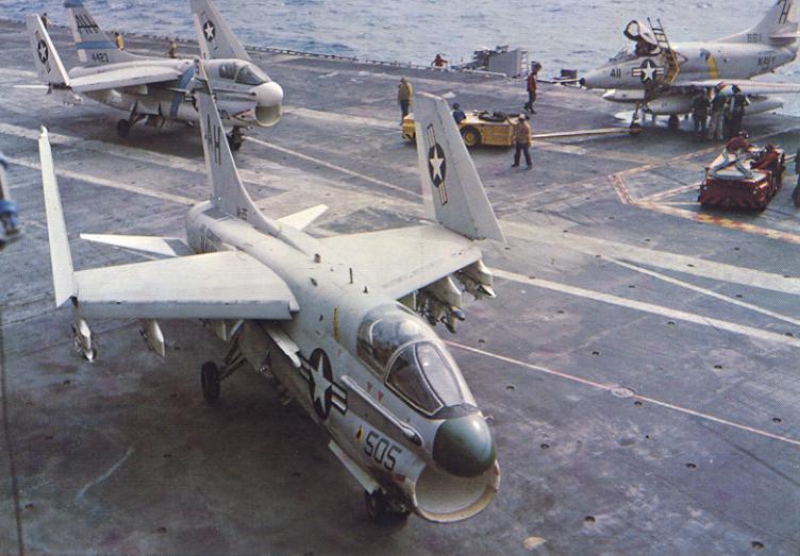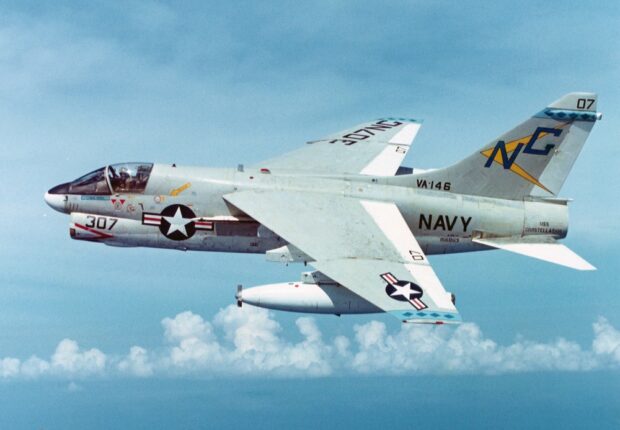As the aviation industry in the 1950s and 1960s embraced supersonic speeds, defined avionics theory, and toyed with eccentric airframe designs, the A-7 Corsair II stood out as a peculiarly fascinating story.
The Corsair II was a unique-looking warplane that lacked the supersonic capabilities of many aircraft of its time but whose reliability and versatility allowed it to stay in service even when its flashier counterparts were being replaced by more ambitious proposals, and it quickly became a crucial asset for the US Navy.
Developed for the Vietnam War, the Corsair II proved to be a trusty and devastating strike aircraft that traded over-the-top features for a formidable range, increased payload capacity, and an affordable price. With its iconic oversized air intake and unique airframe, the warplane would be nicknamed the Sluf or ‘short little ugly f***’ by the Navy crews. Still, there was nothing ugly about its performance…
The LTV A-7 Corsair II is an American carrier-capable subsonic light attack aircraft designed and manufactured by Ling-Temco-Vought (LTV).
The A-7 was developed during the early 1960s as replacement for the Douglas A-4 Skyhawk. Its design was derived from the Vought F-8 Crusader; in comparison with the F-8, the A-7 is both smaller and restricted to subsonic speeds, its airframe being simpler and cheaper to produce. Following a competitive bid by Vought in response to the United States Navy’s (USN) VAL (Heavier-than-air, Attack, Light) requirement, an initial contract for the type was issued on 8 February 1964. Development was rapid, first flying on 26 September 1965 and entering squadron service with the USN on 1 February 1967; by the end of that year, A-7s were being deployed overseas for the Vietnam War.
Initially adopted by USN, the A-7 proved attractive to other services, soon being adopted by the United States Air Force (USAF) and the Air National Guard (ANG) to replace their aging Douglas A-1 Skyraider and North American F-100 Super Sabre fleets. Improved models of the A-7 would be developed, typically adopting more powerful engines and increasingly capable avionics. American A-7s would be used in various major conflicts, including the Invasion of Grenada, Operation El Dorado Canyon, and the Gulf War. The type was also used to support the development of the Lockheed F-117 Nighthawk.

Three aircraft of Attack Carrier Air Wing Sixteen (CVW-16) aboard the aircraft carrier USS Ticonderoga (CVA-14) in 1969 during a deployment to Vietnam: a Vought A-7B Corsair II of attack squadron VA-25 Fist of the Fleet (foreground), an A-7B of VA-87 Golden Warriors (left background), and a Douglas A-4C Skyhawk of VA-112 Broncos (right background)
The A-7 was also exported to Greece in the 1970s and to Portugal in the late 1980s. The USAF and USN opted to retire their remaining examples of the type in 1991, followed by the ANG in 1993 and the Portuguese Air Force in 1999. The A-7 was largely replaced by newer generation fighters such as the General Dynamics F-16 Fighting Falcon and the McDonnell Douglas F/A-18 Hornet. The final operator, the Hellenic Air Force, withdrew the last A-7s during 2014.
Top Photo: A U.S. Navy Ling-Temco-Vought A-7E-5-CV Corsair II (BuNo 156863) of Attack Squadron 146 (VA-146) “Blue Diamonds” in flight on 16 November 1974. VA-146 assigned to Attack Carrier Air Wing 9 (CVW-9) aboard the aircraft carrier USS Constellation (CVA-64) for a deployment to the Western Pacific and the Indian Ocean from 21 June to 23 December 1974.
Sources: YouTube; Wikipedia

